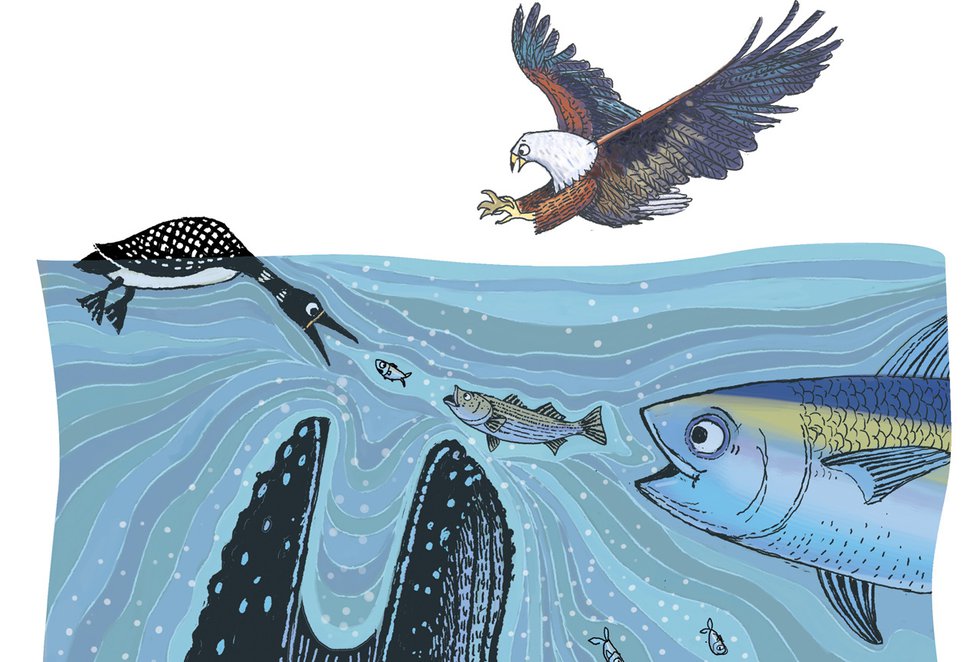You won’t see it on any menus, but the Atlantic menhaden lives to be eaten.

Illustration by Robert Meganck
For a fish that is oily, bony, and has a reputation for going rancid soon after being caught, the Atlantic menhaden is remarkably popular. True, it’s the kind of popularity you wouldn’t envy, as it amounts to a life spent dodging hungry mouths and fishnets. Nevertheless, this close cousin of the herring, shad, and sardine maintains a high status for a lowly filter feeder that swims near the bottom of the food chain.
Atlantic menhaden, or Brevoortia tyrannus, are variously known by colloquial names including bunker, pogy, fatback, and the intriguing-until-you-wish-you-hadn’t-Googled-it “bugmouth.” (This last one is thanks to the fact that menhaden can sometimes play host to a mouth-dwelling parasitic crustacean that resembles a large white grub—and if, like your author, you feel a compelling urge to run an image search, don’t say you weren’t warned.) They swim in big, silvery schools along the Atlantic coast of North America, from Florida to Nova Scotia, but in fall and into early spring, large numbers of the fish congregate off the Virginia and North Carolina capes for spawning.
And spawn they do. In 2016, the latest year for which data is available, an estimated 83,846 billion eggs were produced, according to Chris Moore, senior regional ecosystem scientist for the Chesapeake Bay Foundation; a single mature adult female can produce more than 300,000 eggs. The numbers are necessarily large, though, because the odds are decidedly small for any one of those eggs to make it to adulthood, much less for a menhaden to live out its full potential lifespan of 10 to 12 years.
The eggs hatch within a few days. After some weeks or months, the larvae drift into coastal estuaries—including the Chesapeake Bay, which serves as a vital “nursery” for as much as one third of the juvenile Atlantic menhaden population—where they spend the first months of their lives. Menhaden are filter feeders, consuming phytoplankton when the fish are young and zooplankton when they grow larger. Essentially, menhaden serve to convert the sun’s energy into fish flesh, Moore explains, then transfer that energy up the food chain. “One of the most important ecological functions of menhaden,” he says, “is to be eaten by other species.”
And indeed, Atlantic menhaden are the veritable snack chip of the sea, consumed by everything from striped bass, mackerel, cod, bluefish, and tuna, to osprey, eagles, loons, gannet, and humpback whales. Although you’ve possibly never heard of them, menhaden are regularly referred to as “the most important fish in the sea” because of their vital role in the Atlantic coastal region’s food web.
Can people eat menhaden? Perhaps the more salient question: Would they want to? If the oil-iness and resulting tendency to go quickly rancid and offensively smelly wouldn’t put you off, the fact that menhaden come possessed with a dauntingly large number of tiny bones makes them hardly worth the effort. A filleting knife cutting through menhaden sounds something like working a plastic zip-tie.
That said, although you’ll likely never eat a menhaden directly, there’s a decent chance there’s menhaden somewhere in your meal’s history. Menhaden are popular as bait fish, but the real money in menhaden fishing is made in what is known as the “reduction” industry—which is to say, grinding up boatloads of Brevoortia tyrannus into fish meal, fish oil, and other fishy substances that go into a range of products from livestock feed and plant fertilizer to farmed fish food and human nutritional supplements. More than 128,000 metric tons of menhaden were harvested for the reduction industry just in 2017. The center of the Atlantic coast’s menhaden fishing industry is Reedville, where the majority, by far—around 70 percent—of the annual Atlantic menhaden reduction catch is landed.
For years a heated debate between conservation groups and the reduction fishery has focused on whether or not menhaden are sustainably managed, not only for the sake of the fish themselves, but also for all of the other
species that depend on them. “What we are moving toward in the menhaden management world is ecosystem-based management,” says Moore, “taking into account the needs of all these other species dependent on the menhaden,” rather than looking at menhaden numbers in isolation.
It’s a complex and challenging assessment process, and one further confounded by questions such as what role warming oceans or water quality may play in the life cycle of menhaden, or how much predator demand has increased with the rebounding fishing-bird populations in the Chesapeake Bay region. The issue doesn’t make for easy sorting out, but it illustrates an important principle of 21st-century science: When it comes to our collective global fate, pulling a single thread affects the whole weave.









